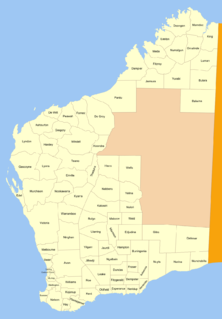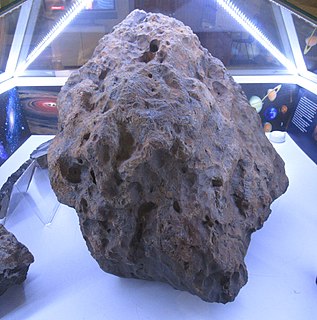
A meteorite is a solid piece of debris from an object, such as a comet, asteroid, or meteoroid, that originates in outer space and survives its passage through the atmosphere to reach the surface of a planet or moon. When the original object enters the atmosphere, various factors such as friction, pressure, and chemical interactions with the atmospheric gases cause it to heat up and radiate energy. It then becomes a meteor and forms a fireball, also known as a shooting star; astronomers call the brightest examples "bolides". Once it settles on the larger body's surface, the meteor becomes a meteorite. Meteorites vary greatly in size. For geologists, a bolide is a meteorite large enough to create an impact crater.

Campo del Cielo refers to a group of iron meteorites and the area in Argentina where they were found. The site straddles the provinces of Chaco and Santiago del Estero, located 1,000 kilometers (620 mi) north-northwest of Buenos Aires, Argentina and approximately 500 kilometres (310 mi) southwest of Asunción, Paraguay. The crater field covers 3 by 18.5 kilometres and contains at least 26 craters, the largest being 115 by 91 metres.

Ilyinets is an impact crater in Ukraine.

Appley Bridge is a small, affluent village crossing the borders of Greater Manchester and West Lancashire, England. It is located off Junction 27 of the M6 motorway and is nestled in the Douglas Valley alongside the Leeds and Liverpool Canal.

Mesosiderites are a class of stony–iron meteorites consisting of about equal parts of metallic nickel-iron and silicate. They are breccias with an irregular texture; silicates and metal occur often in lumps or pebbles as well as in fine-grained intergrowths. The silicate part contains olivine, pyroxenes, and Ca-rich feldspar and is similar in composition to eucrites and diogenites.

A meteorite fall, also called an observed fall, is a meteorite collected after its fall from outer space was observed by people or automated devices. Any other meteorite is called a "find". There are more than 1,100 documented falls listed in widely used databases, most of which have specimens in modern collections. As of August 2021, the Meteoritical Bulletin Database had 1211 confirmed falls.

The Sylacauga meteorite fell on November 30, 1954, at 12:46 local time in Oak Grove, Alabama, near Sylacauga, in the United States. It is commonly called the Hodges meteorite because a fragment of it struck Ann Elizabeth Fowler Hodges (1920–1972).
Dahmani, formerly Abbah Quşūr, is a town and commune in the Kef Governorate, Tunisia. As of 2004 it had a population of 14,061. It is located at 625 meters above sea level, 225 kilometers southwest of Tunis.

A meteor air burst is a type of air burst in which a meteor explodes after entering a planetary body's atmosphere. This fate leads them to be called fireballs or bolides, with the brightest air bursts known as superbolides. Such meteoroids were originally asteroids and comets of a few to several tens of meters in diameter. This separates them from the much smaller and far more common "shooting stars", that usually burn up quickly upon atmospheric entry.
Chambord is an iron meteorite found in Quebec.

Edjudina Land District is a land district of Western Australia, located within the Eastern Land Division.

The Chelyabinsk meteorite is the fragmented remains of the large Chelyabinsk meteor of 15 February 2013 which reached the ground after the meteor's passage through the atmosphere. The descent of the meteor, visible as a brilliant superbolide in the morning sky, caused a series of shock waves that shattered windows, damaged approximately 7,200 buildings and left 1,500 people injured. The resulting fragments were scattered over a wide area.

Tademaït is a natural region in the Sahara Desert right in the centre of Algeria. It is located north of In Salah and south of the Grand Erg Occidental in the Adrar District of Adrar Province, El Ménia District of Ghardaïa Province and the northern end of Tamanrasset Province. It is one of the places of the Sahara Desert where the summer heat is most extreme.
Zagami is the largest single Martian meteorite ever found, weighing about 18 kilograms (40 lb). It landed 10 feet (3.0 m) from a farmer near Zagami, Nigeria, and became buried in a hole about 2 feet (0.61 m) deep. According to Ron Baalke of NASA/JPL, "The Zagami meteorite is the most easily obtainable SNC meteorite available to collectors," referring to the SNC classification of meteorites, of which Martian meteorites belong.
Bunburra Rockhole is an anomalous basaltic achondritic meteorite. Originally classified as a eucrite, it was thought to belong to a group of meteorites that originated from the asteroid 4 Vesta, but has since been reclassified based on oxygen and chromium isotopic compositions. It was observed to fall on July 21, 2007, 04:43:56 local time, by the Desert Fireball Network (DFN). Two fragments weighing 150g and 174g were recovered by the DFN at 31°21.0′S, 129°11.4′E in the Nullarbor Desert region, South Australia in November of the same year. This is the first meteorite to be recovered using the Desert Fireball Network observatory.

Dingle Dell is a 1.15 kg ordinary chondrite of subclass L/LL5, and the fourth meteorite to be recovered by the Desert Fireball Network camera observatory. It fell in the Morawa region of Western Australia on 31 October 2016 8:05 pm local time, and was recovered less than a week later, on the morning of 7 November, in a paddock at Dingle Dell farm. Given the rapid turnaround for meteorite recovery and a lack of rainfall between fall date and find date, the rock is in pristine condition and shows no evidence of terrestrial weathering (W0). This particular meteorite fall demonstrates the proficiency of the DFN as a sample recovery tool for meteoritics.
Dimmitt is a meteorite that fell in prehistoric times in The United States. It was named after the nearest town of Dimmitt, Texas.

Northwest Africa 801 is a carbonaceous chondrite meteorite found in 2001 in Morocco. It has a mass of 5kg and was purchased in Zagora, Morocco. At over 4.5 billions years old, it is older than the Earth. In November 2019, along with the Murchison meteorite it was the first to provide evidence of ribose in space and its transport to Earth, in an analysis of its composition by gas chromatography mass spectrometry. According to Yoshihiro Furukawa of Tohoku University, "the extraterrestrial sugar might have contributed to the formation of RNA on the prebiotic Earth which possibly led to the origin of life."
Tagounite is a rural Moroccan commune in the Zagora Province, Drâa-Tafilalet, Morocco, with about 17,412 inhabitants as of the 2004 census.













